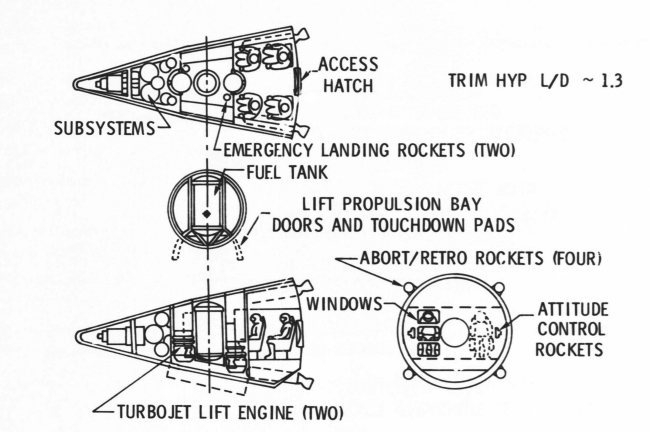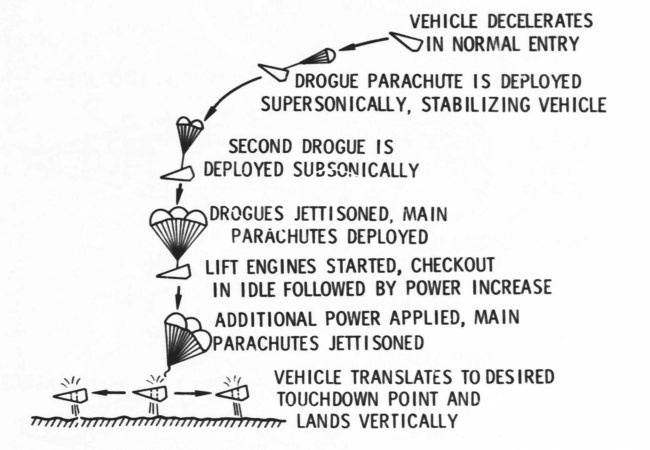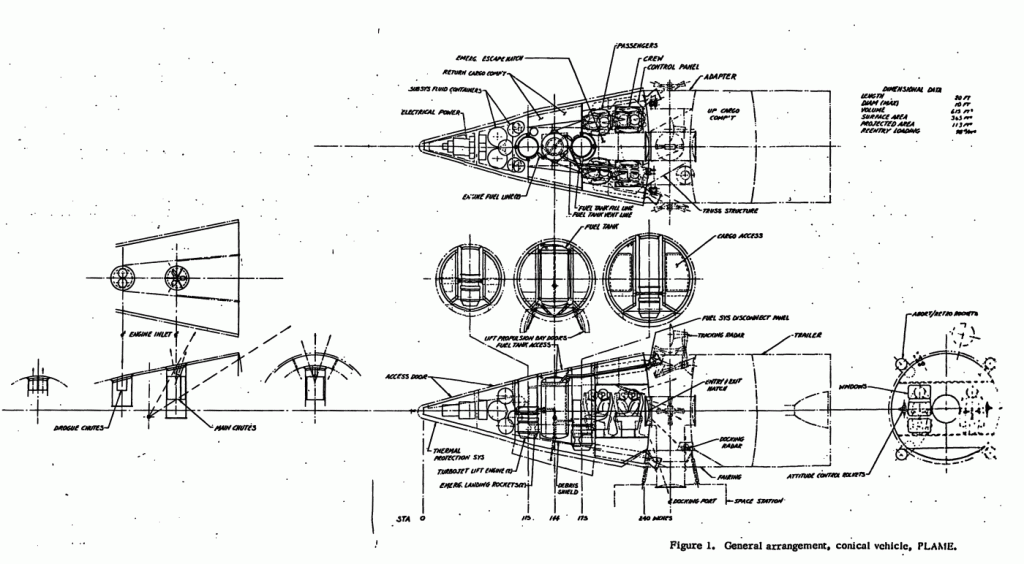One idea from the dawn – or at least pre-noon hours – of the space age that I think might be worth considering for a comeback is the “Propulsive Lift Landing Aid for Entry Vehicles,” or “Propulsive Lift Concept for the Descent and Landing of Manned Entery Vehicles” which mysteriously but fortunately boils down to “PLAME.” Studied by General Dynamics around 1967, PLAME was a concept for using turbojet engines to provide vertical thrust for the landing of space capsules or small spaceplanes. The turbojets were big, and required further volume for their inlets and exhaust; but modern designs would make them smaller, lighter and more fuel efficient. The amount of fuel they’d need would be limited due to their short run time… and being turbojets, there’d be no need for oxidizer, just stock-standard jet fuel.
For future passenger/tourist space vehicles, I’d imagine that a system like this might be an effective way to provide a safe land-landing system. A single conical or biconic space capsule would be a cheaper and lighter vehicle than a wing-body or lifting body (with notably less crossrange, of course); a PLAME system would allow a capsule to not only land on the ground (rather than ocean splashdown), but also would make the capsule largely independent of runways. A PLAME-equipped capsule could land pretty much anywhere that something like a Harrier could land.
Of course, a rocket system could be used instead of a turbojet system. It might be interesting to compare the two for use in the *same* capsule. Design the capsule to use turbojets… and then remove the turbojets and place rockets in the inlet/exhaust duct. Use the ejector effect to increase the thrust of the rocket. Trade studies might just show that a pure rocket system would weigh less than a turbojet system.
A system like this would allow, say, SpaceX or some other firm to launch tourist space capsules from Florida, and recover the capsule right next to the launch site. This would not only speed up and simplify processing of the capsule for the next flight (a not inconsiderable concern), it would also get the tourists on their way that much faster and safer. After having just spent days or weeks in space, they might – or might not – be in the mood to bob around in the ocean waiting for pickup. With a PLAME-capsule, they could be back out and about within a minute or two of landing, just yards from the airport terminal.
10 Responses to “Propulsive lift capsules”
Sorry, the comment form is closed at this time.



This is an idea that would retain a lot of the dignity that Shuttle provided – that is that when you land you walk off the craft rather than waiting around for frogmen, helicopters or guys in SUVs to bring the disembarking “slide”.
I also like that you land where you took off. That way the ride back to your car in long term parking is much shorter – and you don’t need to worry about the farmer whose field you landed in being surprised to see you!
It’ll be interesting to see if SpaceX really goes through with crewed land landings with their abort motors – but do they process the Dragon in Florida or California?
Some more resources
http://www.astronautix.com/craft/mtkva.htm
Big Orion http://forum.nasaspaceflight.com/index.php?topic=33500.0
Is it really possible to build a pair of turbojets capable of landing a spacecraft that are still lighter and more compact than, say, a couple of big parachutes or even a parawing?
The jets would still require chutes. The chutes would get the capsule *to* the landing area; the jets would get the capsule down with precision.
That just makes it sound even more impractical.
Here is some artwork of something similar:
http://frassanito.com/work/images/planning01.jpg
Larger:
http://www.astronautix.com/craft/mtkva.htm
Soyuz is sort of half-way there, isn’t it?
Of course, it doesn’t detach its chutes.
> Soyuz is sort of half-way there, isn’t it?
Sort of. Soyuz uses rockets for deceleration just at touchdown. PLAME would use thrust not just to cushion landing, but to control landings.
I agree it would be nice to have more control over landings, but I’m not sure about the cost.
In Slide Rule Neville Shute states that since they couldn’t get reversible gears to work properly, the British R-101 dirigible carried an engine that faced forward to provide reverse thrust during landings. “This engine would ride as a passenger for most of the trip, cutting into payload, to be run a few minutes at landing.”
Spacecraft landing systems are the same way. They take the whole trip, but they’re only used for a few minutes at touchdown.
Well, the SLS looks to be able to haul a modest capsule with some Cargo aft of it (LEM-stowed)–or it could haul a pretty sizable capsule. The Marines wanted something similar for a project called SUSTAIN. perhaps the last gasp of the Medaris/Bono troop rocket concept…